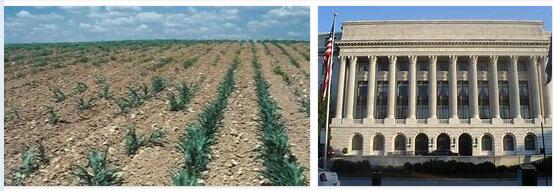Climatic and pedological conditions extraordinarily favorable are among the fundamental factors that have favored the exceptional development of American agriculture: every resident of the United States has a cultivable area that is at least 3 times greater than that enjoyed by the rest of humanity. To the excellent natural resources, however, we must add the extreme rationalization of agriculture, an activity characterized from the beginning by a very precise adaptation to the environmental conditions of both the crops and the size of the farms – from a few tens to several thousand ha – and, finally, cultivation techniques (use of fertilizers, fight against soil degradation, irrigation techniques, etc.). In these immense spaces, marked by the low density of the population, mechanization. Finally, the human element should not be underestimated. Farmers, often associated in consortia to better guarantee secure incomes in a sector structurally exposed to recurring dangers and generally closely connected with the food industries, receive very high technical training and constant updating. Paradoxically, while the primary sector plays an increasingly less important role in the national economy, both in terms of the number of employees and as a percentage of the national product, it occupies a formidable position in the international field. Thanks to the ever increasing unit yields obtained in agriculture – for certain products, such as soy,that are realized, the United States has managed to establish itself as an authentic food power: there are now many countries, even outside the Third World, that depend, to a greater or lesser extent, on the supply of American food. To achieve the full exploitation of territorial resources, agriculture and livestock have been set up, from the outset, on a regional basis, thus adapting them to the natural possibilities of the various areas, on the basis of a complex and integrated vision of the various productions within the country. This division into belts, or “belts”, more or less monocultures (Wheat Belt = wheat belt; Corn Belt = corn belt; Cotton Belt = cotton belt; Dairy Belt = milk belt), has remained, over the years, to a large extent valid, even if little by little the belts have split into more articulated subunits. Despite the greater variety, the general characteristics of this zonal agriculture remain and represent one of the fundamental components of the American agricultural landscape. United States is a country located in North America according to ESTATELEARNING.COM.
THE CROPS OF THE DIFFERENT GEOGRAPHICAL AREAS
The North Atlantic and Great Lakes region, heavily urbanized since the origins of the country’s population, has promoted agricultural activities capable of supplying products required by the cities; favorable environmental conditions for barn farming have characterized this region in a widespread way, to the point that it is still known today as the Dairy Belt (Wisconsin, Minnesota, etc.). The Appalachian region is dominated by various crops, including fruit and vegetables, usually grown on rather small estates, at least in relation to the average size of US farms. In the northeastern section of the Central Plains, from the Ohio Basin to Iowa, where rainfall is still abundant, there is the great Corn Belt, the corn region (Iowa, Illinois, Indiana, Minnesota, Missouri, Nebraska and Wisconsin), the true heart of American agriculture, which benefits from excellent soil conditions and allows for very high yields. The southern belt is the Cotton Belt, which from the southeastern USA (Mississippi, Alabama etc.) has however gradually moved, due to the impoverishment of the soils, towards Texas, today the largest American producer of cotton, and the irrigated areas of Southwest; cotton plantations are gradually shrinking, while in the Cotton Belt new, more profitable crops have been successfully established, such as soybeans, which is also widespread in Illinois, Indiana and Iowa. The coastal strip of the Gulf of Mexico and Florida, on the other hand, form a region of subtropical fruit-bearing crops, such as citrus fruits, pineapples, etc. AW of Mississippi, where rainfall is now poor, there is the Wheat Belt, the grain region that actually includes two distinct areas: a northern one (North Dakota, Montana etc.), where the harsher climate adapts to the cultivation of spring wheat, and one southern (Kansas, the largest producer in the USA, Oklahoma, etc.), the largest and most profitable, where winter wheat is obtained. The farms are generally vast, ranging from 100-150 ha, on average, in Kansas, to 800-1000 ha in the westernmost properties, on the edge of the semi-arid zone; the organization is extremely rational and the degree of mechanization is very high. Dry farming and extensive farming are widespread throughout the Rocky Mountain region and in the West (Utah, Nevada etc.). Here agriculture is made possible by massive irrigation works (in the United States the irrigated area is about one tenth of the total cultivated); various crops are practiced there, from cotton to fruit growing, including subtropical ones, as in the California Valley, which is home to vineyards (the vine, introduced by Italians, French and Spanish, is very profitable and makes the United States the fourth largest wine producer world) and fruit trees of various species. Overall, the cultivated area is equal to almost one fifth of the national territory; as for individual productions, US agriculture holds numerous world records. Colossal is the production of corn, of which it is the largest producer and exporter country. The data is even more significant if we consider that almost 70% of this crop is used as fertilizer for farm animals. A considerable boost to the price of corn is also due to the increase in the production of ethanol, used for biofuels. As a result of this growth, there was also a rise in prices on a global scale, influenced by the parallel increase in the prices of fossil fuels, which reverberated on a world scale, causing a return of interest in agriculture. On a national level, repercussions were also recorded in relation to the distribution of crops on arable land: in 2007, the land occupied by maize increased by about one fifth, to the detriment of wheat cultivation, of which the United States occupies the third place for quantity produced, with the consequent decline in exports. Sorghum (Arizona), barley (North Dakota), oats (Minnesota) and rice (present in the irrigated areas of the South and South-West) complete the picture of the main cereal crops. The production of potatoes is also high, grown mainly in the northern states, especially in Idaho; the sweet potato is also widely used (batata). The main horticultural productions concern tomatoes, onions, cabbages and beans; more important, however, is fruit growing as a whole, widespread both in the temperate zones of the East and West, and in the subtropical ones of the South and especially in California. The country produces large quantities of apples, peaches, pears and plums. Overall, the United States is the fourth largest fruit producer in the world and the third largest citrus fruit (especially California and Florida, where grapefruit predominates).
INDUSTRIAL CROPS AND FORESTS
As for industrial crops, cotton stands out, for whose fibers the USA holds the second place on a world scale among producing countries; however, the percentage with respect to world production is continuously decreasing, in proportion to the increase that cotton growing has registered in many other countries, starting with China. With massive annual seed production, US cotton also fuels a mighty oil industry; among the oilseeds, however, soy clearly predominates, followed by peanuts, sunflowers and flax. The other two main industrial productions are tobacco, whose crops, often present with very valuable qualities, form a real belt in the southern Appalachian region (North Carolina, Kentucky, Virginia, etc.), and sugar beet, widespread throughout the northern and western part of the country, in California, Idaho and Colorado and which, together with sugar cane (Hawaii, Louisiana, Florida), feeds a considerable sugar industry. § As for the forests, which cover 33.1% of the national territory, their exploitation gives rise to very significant activities in the Appalachian region, in the South and especially on the northern slopes of the reliefs along the Pacific coast (Tacoma is considered the capital of the timber), from which the prized douglas fir is obtained. Forest exploitation is highly rationalized and the production of timber is significant (over half of which is made up of conifers). Great furniture factories are based on forest products, mostly centralized in the North Atlantic metropolises (New York, Jamestown, Grand Rapids, Chicago, etc.) and in the Great Lakes, and colossal industries, especially those of wood pulp and paper, of which the United States is the world’s leading producer.



